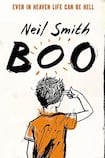
Life on earth wasn’t easy for teenager Oliver Dalrymple, a self-confessed pariah and science geek, nicknamed “Boo” by his schoolmates on account of his “ghostly pale skin” and “staticky, whitish-blond hair.” The ethereal image is apt. Boo has recently left earth, having dropped dead in front of his locker at a suburban Chicago high school.
An introverted child with autistic tendencies, Boo had a chronic heart condition, which he believes to be the cause of his death. The arrival of his schoolfriend Johnny Henzel in heaven, aka Town, tells a different story. Both boys were shot dead by the crazy “Gunboy”, an unidentified pupil who went on a killing spree on an otherwise ordinary school day.
Boo sets out its stall from the beginning, using a clear structure and narrative arc that will appeal to both young adult and older readers. As Boo and Johnny try to adapt to their afterlife in Town, a world of 13-year-olds who never grow up, they embark on a journey to discover who killed them.
This is Canadian writer Neil Smith's debut novel, following an award-winning collection of short stories, Bang Crunch, in 2007. From Montreal, Smith grew up in Chicago and has since returned to his home city to work as a translator.
The plot of Boo has real-life resonance for the author, who was on campus at the Université de Montréal in 1989 when a 25-year-old man, Marc Lepine, shot and killed 14 female engineering students. One of the stories in Bang Crunch details the aftermath of such a massacre at a university. In Boo, Smith moves to a high-school setting, where the focus is on bullying and mental health.
For all its dead characters, the novel is alive from the outset. Town is a captivating landscape, far away from Hollywood notions of heaven. The tagline on the book’s cover – “Even in heaven, life can be hell” – prepares the reader for horrors, but instead the author cleverly offers a banal no-man’s-land of an afterlife that is neither stereotypically hellish nor heavenly, just utterly believable.
Unknown afterlife
Town is a world of do-gooders and mundanity. Wards must stay for 50 years before their god, Zig, allows them to pass to another unknown afterlife. Take a moment to imagine being 13 for 50 years. Then imagine it happens in a land of vegetarian health food – and no ice-cream – where kids get grounded, sent to prison, or put in mental institutions if they’re “sadcons”, where concrete walls 25 storeys high make escape impossible: “Sometimes groups of townies gather at the foot of a wall and scream or sing together in hopes that somebody on the other side will answer back.”
No pits of fire or pitchforked demons, but hellish nonetheless. The gloom is undercut by Boo’s likeable voice, a mix of observation and humour as he documents the afterlife and the new friends he makes along the way. Endearingly pedantic, Boo sets up the narrative in the form of a story to his parents back home. He lays things out literally, with Smith poking fun at certain writerly conventions: “I will tell you right away that the next scene is a dream. I dislike stories where a dream is presented, even briefly, as reality.”
The short chapters, headed by elements of the periodic table, make for an easy read, with a decent amount of mystery surrounding the boys’ deaths. As the jaunts across Town continue – road trips, bloody fights, incarcerations and murder trials – the book goes more into young adult territory. The suspense of the plot is of a simplistic and potentially guessable nature. What is far from simplistic are the themes at the core of the novel, which examines random acts of violence and the havoc they wreak.
Town is full of "sadcons" and "gommers", murdered children bent on revenge. Presiding over it all is the fallible Zig, a Wizard of Oz-type figure who communicates with his wards through cockroaches. There are plenty of literary nods, with various locations named after well-chosen fictional characters. Outcasts feature prominently: Boo Radley Road, John Clayton Street (referencing Tarzan's alter ego) or the Mary Lennox Infirmary, which recalls the unloved child protagonist of The Secret Garden. This intertextuality works as it places Boo and Johnny in a wider world of troubled characters, and all the wrongs inflicted on them down through the literary ages.
Magical in its setting and plot, there is also a strong element of fable to the book. Close to the end, Boo realises the imperative of telling the boys’ story so that they, and America, can better deal with similar crises in the future.
As they search out answers in the here and hereafter for the unpredictable actions of humankind, the graffiti carved on Boo’s favourite bench rings its message home: “Eternal happiness is just plain crazy.”












